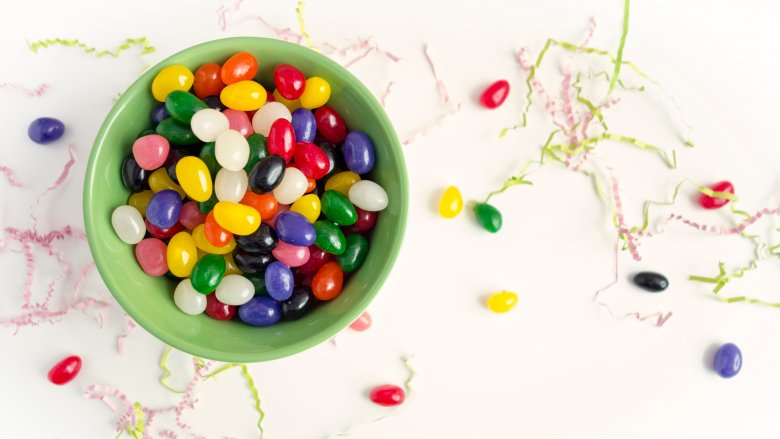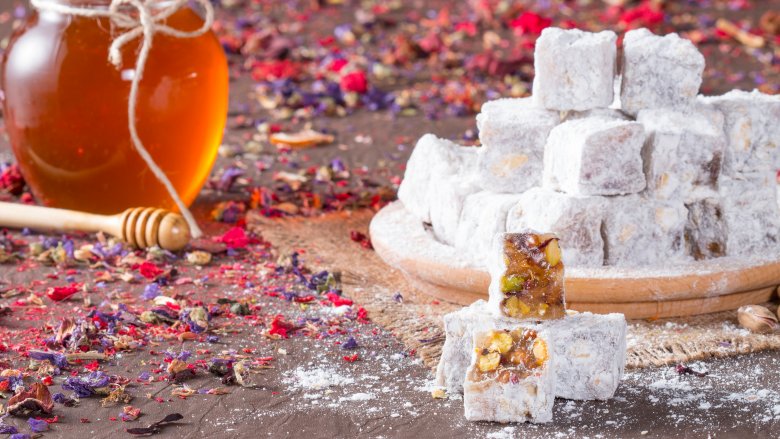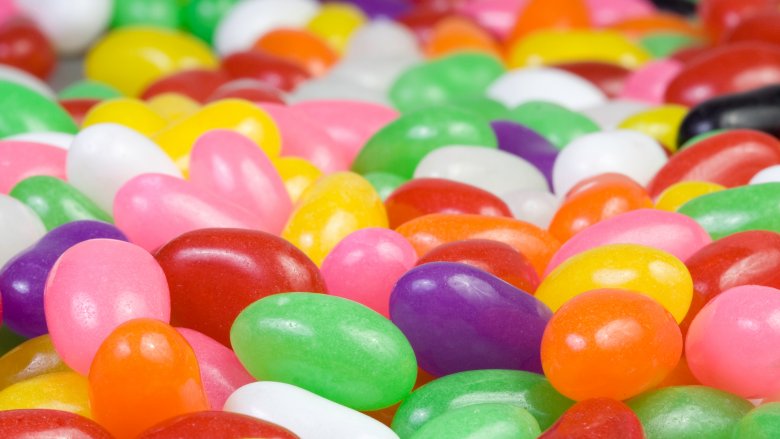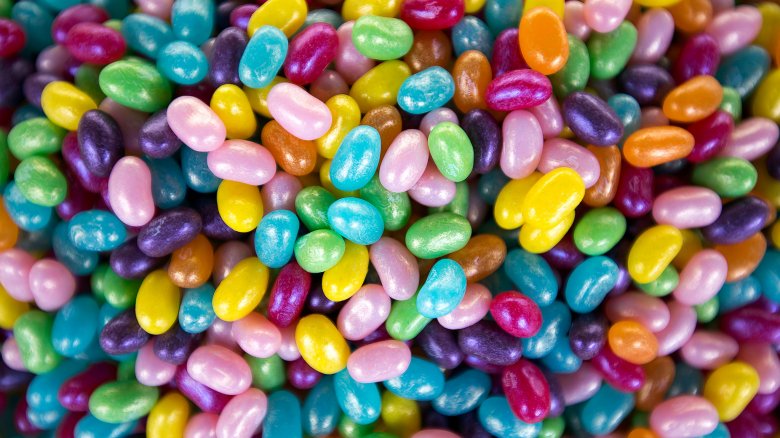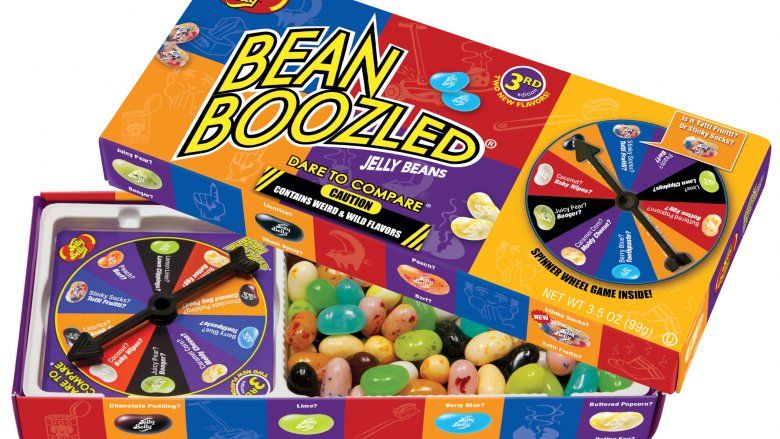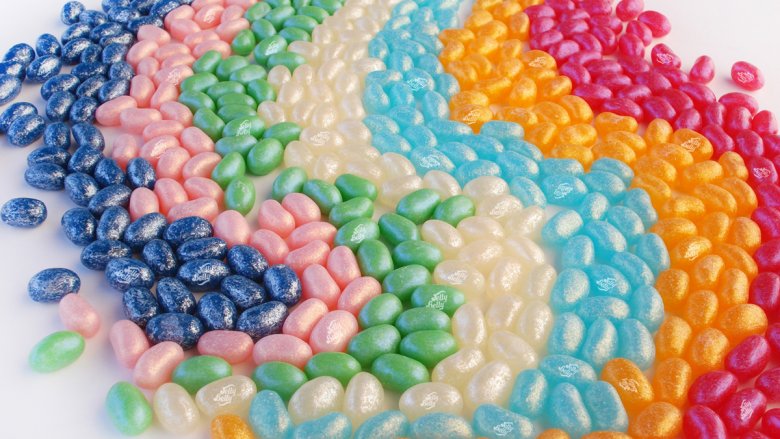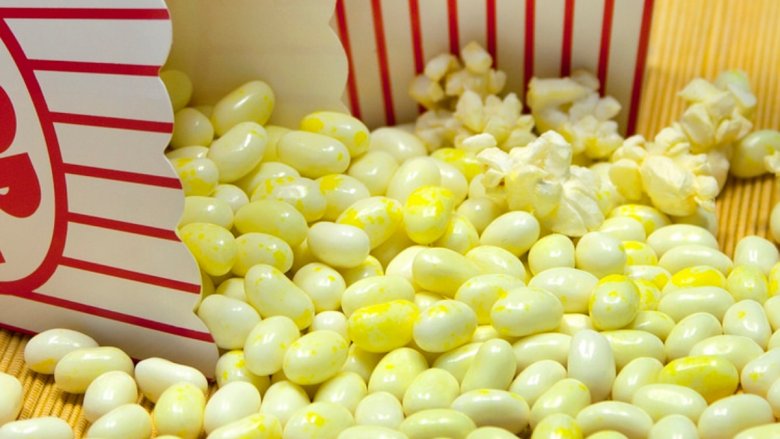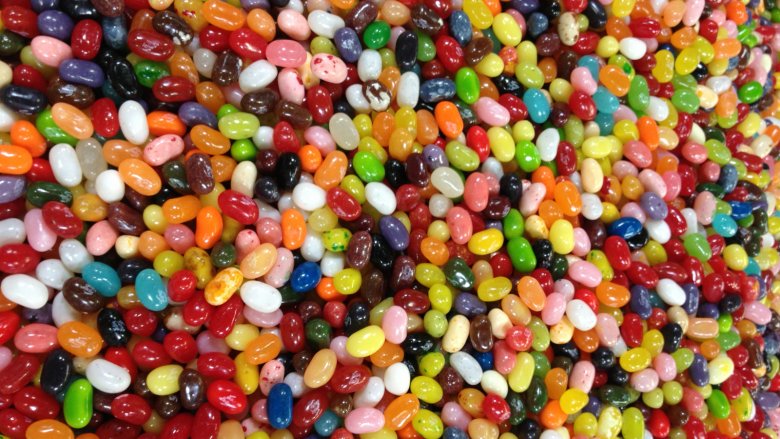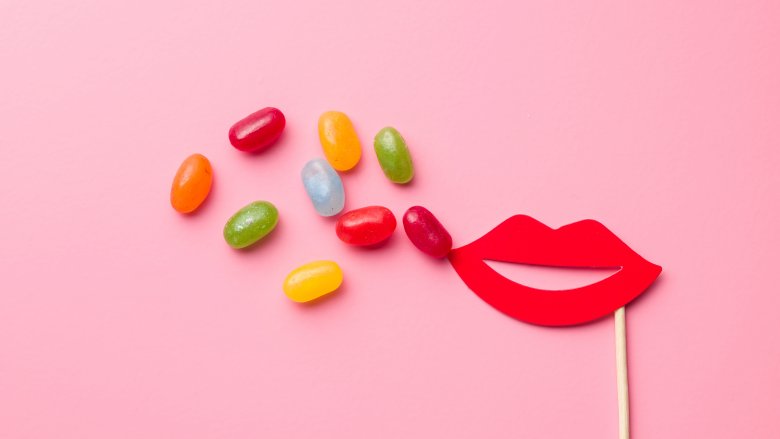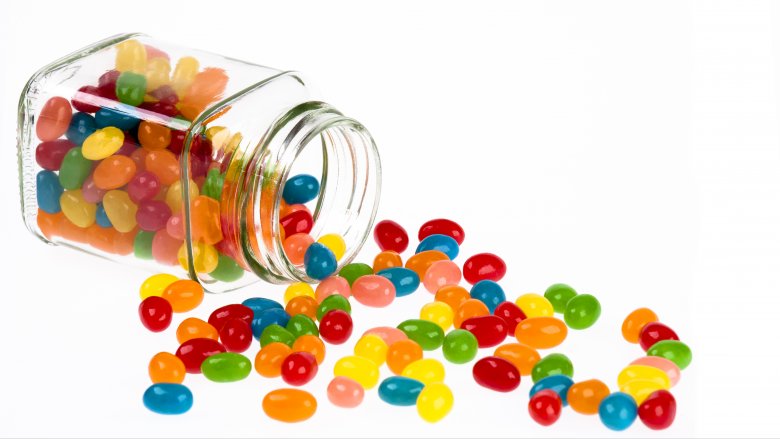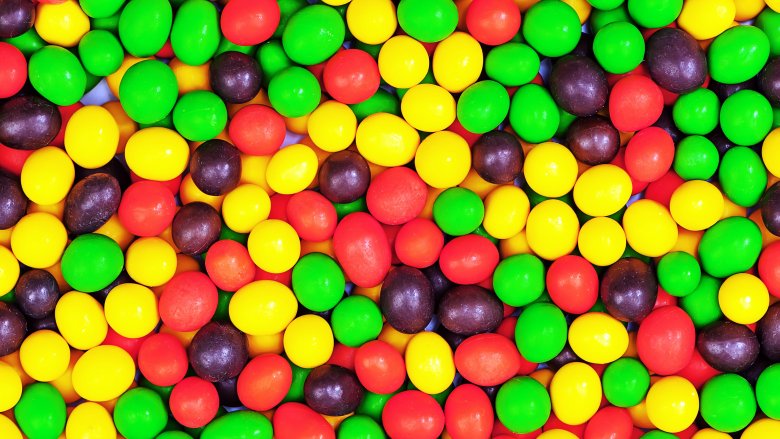The Untold Truth Of Jelly Beans
When you love jelly beans, you don't need to wait until April 22 — National Jelly Bean Day — to celebrate these sugary spheres. For you, every day is jelly bean day. Whether you're a fan of the generic drugstore version or the gourmet varieties with dozens of intense (and sometimes intentionally disgusting) flavors, you never pass up the chance to savor a handful or 10 of jelly beans.
Have you ever stopped to think about where jelly beans came from, though? How about how they're made? Heck, there are even storage hacks that can help you keep your jelly beans fresh and safe practically forever. These are things any true jelly bean fan should know, friends. If for no other reason, learning more about your favorite confections will give you a more robust appreciation for their delightful taste.
Besides, for being such a tiny treat, there are some big backstories and quite a few fun facts embedded into the jelly bean's history. So, grab yourself a bag, sit back, and prepare to take your fandom for these ambrosial orbs to the next level when you learn the untold truth of jelly beans.
They may be of Middle Eastern origin
Sorry to break it to you, fam, but the first jelly beans were not made with magic by the Easter bunny. Well, at least not that anyone knows of — per Jelly Belly, the exact origin of the jelly bean is a bit murky, so anything's possible, right? But there does seem to be a general consensus among jelly bean aficionados and other knowledgeable beings as to the roots of this sweet treat. "Most experts believe the soft center is a descendant of a Mid Eastern confection known as Turkish Delight that dates back to pre-Biblical times," Jelly Belly points out on their website.
If you're not familiar with Turkish Delight (or lokum), it is a Turkish delicacy with a gummy-like center that is a mixture of starch, sugar, and chopped fruit or nuts. They're sometimes infused with things like rosewater or lemon for added flavor. And they're dusted with powdered sugar to keep them from getting too sticky. Sound familiar? Turkish Delight made a cameo in C.S. Lewis' classic The Chronicles of Narnia book series, and the 2005 film The Chronicles of Narnia: The Lion, the Witch, and the Wardrobe. The White Witch uses the confections to convince Edmund to betray his siblings.
Who knows what he might have told her if he'd gotten his hands on some jelly beans, eh?
They've reportedly been around longer than cars
It might seem like a strange thing to ponder the life of a candy. Really, most of us don't consider much about candy other than how delicious it tastes. But jelly beans actually have a storied and quite interesting history. If you're going to gobble them down, the least you can do is learn a little about them first.
In that spirit, let us travel back in time to 226 AD in the Persian Empire. That is reportedly when and where the Turkish Delight got its start. In the 1750s, according to True Treats Historic Candy, Sultan Abdul Hamid I began having daily batches of the treat prepared to satiate his harem of wives. In 1870, it was referenced in literature, making an appearance in Charles Dickens' The Mystery of Edwin Drood. It was also in the mid-1800s when an unknown candy maker in Boston reportedly took Turkish Delights and "panned" them — a process by which a food is rolled in layers of sugar to create a smooth shell — to create jelly beans as we know them today.
Considering the automobile wasn't patented until 1886 by Karl Friedrich Benz and Gottlieb Daimler, jelly beans predate cars.
It can take up to three weeks to make one
It may take mere seconds for you to scarf a handful of jelly beans down, but make no mistake — it takes much longer to create them. How long? Per Jelly Belly, one of the most famous purveyors of the candies, it takes seven to 21 days to make a single jelly bean.
It's only natural at this point to wonder how in the world such a tiny treat could take so long to spin into existence. The truth is there's essentially a metric ton of steps involved, explains Wonderopolis. First, manufacturers must heat liquid sugar to around 350 degrees Fahrenheit. Starch and glucose is mixed in before pouring the mixture into molds shaped like — you guessed it — beans. That mixture must be left for a day to dry so that the jelly beans develop their distinctive chewy texture.
Once the beans are removed from the molds, they're steamed and coated with even more liquid sugar and popped into a spinning machine. There, colors and flavors are added. And that's not even it! As the spinning process nears its end, grains of sugar are poured into the machine roughly four times. This endows jelly beans with their hard outer shell, while hot syrup and wax make that shell shine.
All in all, the process can take up to three weeks. But it can be described in three words: worth the wait.
Smell is the secret behind the gross flavors
Any self-respecting Harry Potter fanatic has undoubtedly summoned up the courage to try Bertie Bott's Every Flavour Beans. Maybe you got ear wax or rotten egg. Or, if you were truly unfortunate, maybe you found yourself with a mouth full of vomit-flavored jelly bean. In that moment, you likely had two thoughts: 1. What were you thinking? 2. How in the world do they manage to make jelly beans taste just like these disgusting things?
According to Jelly Belly spokesperson Jana Sanders Perry, it's a point of pride for the company. "We're nothing if not committed to making flavors as true to life as possible, and that includes the wacky flavors, too," Perry told Mental Floss. In order to do that, the company relies on the help of a gas chromatograph to analyze the real-life gross things. It then converts those things into vapors in an oven, analyzes the chemical makeup of the vapors, and turns them into flavor markers.
Just how committed are they to authenticity? Well, when their BeanBoozled line introduced a flavor called Stinky Socks, "our flavor scientist aged his own socks in a sealed plastic bag for a couple of weeks." Blech.
Don't worry, though — that vomit-flavored bean didn't involve actual vomit in the gas chromatograph. "The Vomit in the Bertie Bott's and Barf in BeanBoozled lines were born from the humble attempt to make a pizza-flavored jelly bean," Perry explained. "Attempt after attempt was rejected by our taste testers because the cheese flavor of the pizza was not palatable."
Those shiny shells? Beetle poop!
At some point, we've probably all been informed that — surprise! — we inadvertently eat bugs. A study completed by Terro went so far as to suggest that "it's possible for one person to ingest nearly 140,000 pieces of insect matter each year". What you've probably never heard, though, is how much insect poop you're ingesting. Yep, poop. Or at least something very much like it.
Per Mental Floss, jelly beans get that nice sheen on their candy exteriors from shellac — a resin secreted by the female lac bug (laccifer lacca) after drinking the sap of trees. How does that secretion then end up in your jelly beans? After the bug, ahem, deposits shellac onto trees, it is harvested and processed into flakes. Those flakes are then dissolved in ethanol, and the resulting liquid shellac is sprayed onto everything from hardwood floors to jelly beans to make them shiny.
So, if you're a vegan or vegetarian, it might be time to say goodbye to jelly beans for good.
Your favorite flavor might depend on where you're from
When you really love jelly beans, picking your favorite flavor is kind of like picking a favorite child. But even if we don't admit it, most of us definitely lean toward one flavor in particular. Whether you're eating generic jelly beans and simply crave whatever flavor "purple" is, or you're chowing down on gourmet jelly beans, you likely sift through the bag to ferret out your favorite flavor.
Interestingly, which flavor you like most might be easy to predict depending on what part of the country you're from. Using jelly beans sales data from the last decade — along with SurveyMonkey and Facebook polls of over 12,000 people — CandyStore.com pinpointed the most loved jelly bean flavors in all 50 states and the most popular flavors nationwide. What it found might just surprise you.
The most favorite jelly bean flavor in America could be the most polarizing: buttered popcorn. 11 states bought more buttered popcorn jelly beans over the last 10 years than any other flavor. Somehow, prior to buttered popcorn taking the title of favorite jelly bean flavor, black licorice reigned as number one. It didn't fall too far, though. Black licorice still comes in as the nation's number two favorite; the top flavor in eight states. Rounding out the top three? Sweet and spicy cinnamon. Maybe we just have weird taste in jelly beans?
Billions of jelly beans are sold for Easter
People celebrate Easter for different reasons: tradition, religion, just plain fun. But there is little doubt that candy companies celebrate the holiday for another reason altogether, and that reason is profit. If you think about how much candy you alone consume, it might not surprise you too much to hear that Easter proves to be a massive money-making holiday for confectionary purveyors.
How big? According to a 2017 report by TheStreet, Easter spending hovers around $18.4 billion, and candy is the most popular spending category. It accounts for $2.6 billion in total Easter sales which translates to more than 120 million pounds of candy. Although chocolate remains the most popular Easter candy, jelly beans definitely qualify as an Easter staple — according to the National Confectioners Association, more than 16 billion jelly beans were expected to be sold during the oh-so-sweet holiday.
Of course, it goes without saying that jelly beans are popular year-round. Easter just boosts the annual consumption total to a stratospheric level. Seriously. Per Jelly Belly, enough of their beans were eaten in the last year to circle the earth more than five times.
Ronald Reagan loved 'em so much, he sent 'em to space
A quick tour around the Jelly Belly Candy Company of Fairfield, California, will make it abundantly clear that the makers of said jelly beans are major fans of former President Ronald Reagan. And why they were such big fans of the Gipper has much to do with the fact he was perhaps their biggest fan.
Per Britannica, Reagan became hooked on Jelly Belly jelly beans when he was campaigning for governor in 1966. During that time, he was trying to kick his pipe smoking habit — jelly beans became his stand-in. By 1967, Reagan was totally hooked. So much so that when he left office, he wrote a letter of gratitude to the Jelly Belly Candy Company (then known as the Herman Goelitz Candy Company). "They have become such a tradition of this administration that it has gotten to the point where we can hardly start a meeting or make a decision without passing around a jar of jelly beans," Governor Reagan wrote.
When Reagan became president in the '80s, he placed a standing order of 720 bags of Jelly Belly jelly beans per month to be spread among the White House and other federal buildings, according to Atlas Obscura. That's a whoppin' 306,070 beans, in case you're curious.
Reagan adored the jelly beans so much, in fact, that he sent a secret stash into space when the space shuttle Challenger launched with the first female astronaut, Sally Ride.
This sweet treat is also an insult
One would think that calling someone a jelly bean might have sweet implications, given the candy's sugary composition. However, if someone happens to call you a jelly bean, you might have cause to be offended. Oprah.com defines "jellybean" in The Faulkner Glossary as "1920s slang for a self-consciously fashionable adolescent male." Which, let's face it, doesn't actually sound all that insulting. But the term's use in Faulkner's The Sound and the Fury suggests it was meant as a dig: "'Are you hiding out in the woods with one of those dam slick-headed jellybeans?"
The term popped up again in 1920s literature with the publication of F. Scott Fitzgerald's second collection of short works, Tales of the Jazz Age. However, the definition of Fitzgerald's Jelly-bean differed slightly from that of Faulkner's. In a story titled "My Last Flappers, The Jelly-Bean," Fitzgerald paints an unflattering picture of a protagonist. "Jim Powell was a Jelly-Bean. Much as I desire to make him an appealing character, I feel that it would be unscrupulous to deceive you on that point," Fitzgerald wrote, adding, "He was a bred-in-the-bone, dyed-in-the-wool, ninety-nine three-quarters percent Jelly-bean and he grew lazily all during Jelly-bean season, which is every season, down in the land of the Jelly-beans well below the Mason-Dixon line."
So, basically, being called a jelly bean either means you're pretentious or lazy. Take your pick?
There's a cool secret to prolonging their shelf-life
If we're all really being honest with ourselves, most jelly beans don't last long enough to be stored anywhere other than our digestive systems. But maybe you bought a bulk bag or you're trying to exercise willpower, in which case you don't want your jelly beans to get "crunchy" before you can enjoy them.
There's a hack for that, and it's quite literally a cool one — you should be freezing your jelly beans. "Properly stored [in the freezer], jelly beans will maintain best quality for about 12 months but will remain safe beyond that time," Still Tasty advises on their website. And if jelly beans are kept constantly frozen at zero degrees Fahrenheit, they'll stay safe "indefinitely." This is especially impressive when you consider that jelly beans only last eight to 10 months at room temperature (say, in a pantry) or in the refrigerator.
So, what's the proper freezer storage protocol? It's rather simple. You just need to place your jelly beans in a tightly sealed airtight container or heavy-duty freezer bags, then stash them on one of your freezer shelves. Voila! Jelly beans for life.
Skittles are technically jelly beans, too
Ready to have your mind blown? A jelly bean is defined as "a candy that is shaped like a bean and has a hard sugar shell with a soft center." Another beloved candy, Skittles, matches that definition. The only difference is the fact that jelly beans are described as "bean-shaped," whereas Skittles are round. This can be seen as a mere matter of semantics, though, since there are some bean varieties that are round (think garbanzo). Plus, real talk, who among us hasn't gotten a weird-shaped Skittle that looks like it could be the jelly bean's cousin?
Another way Skittles are jelly bean-like is taste — although, admittedly, this is up for debate. Some people contend that all Skittles have the same flavor but simply have different colors. However, Mars Wrigley Confectionary, the company that makes Skittles, insists that isn't so. In 2018, a spokesperson for the company adamantly told Today, "Each of the five fruity flavors in Skittles has its own individual taste and flavor."
Per the spokesperson, original Skittles boast the flavors of strawberry, green apple, grape, lemon, and orange. The flavoring is achieved through both the hard-candy shell and the chewy center. Sounds like a jelly bean, no?
